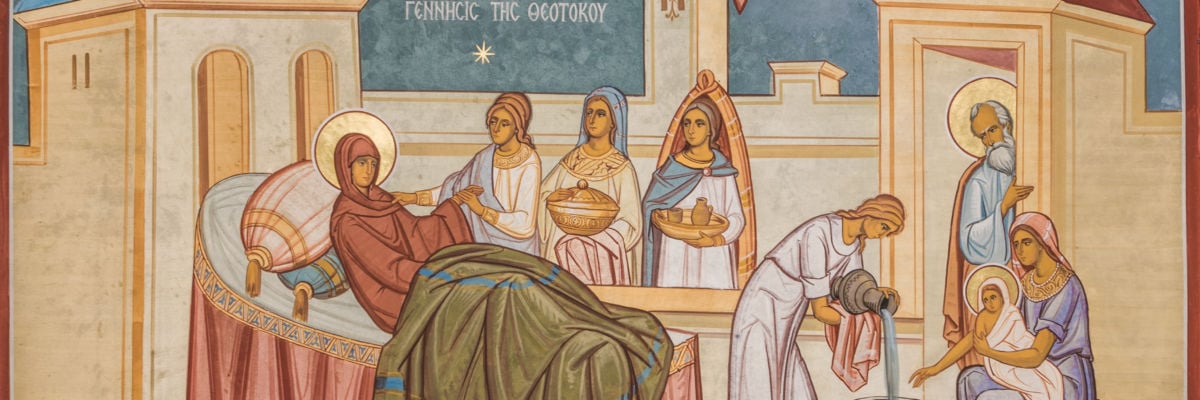
Does the Eastern tradition in Christianity, whether Eastern Catholic or Orthodox, reject the Latin Christian doctrine of the Immaculate Conception? Does the Eastern tradition reject the Augustinian, Latin Christian notion of Original Sin implied in the Marian dogma?
Here is the first part of a two-part series. We’ll answer the first question here, touching upon the second, too, as the two are strongly linked. But we will tackle the second question in greater detail next week.
The shortest answer to both questions is no, absolutely not, if one examines the actual tradition of the liturgies and Fathers of East and West.
What of the Immaculate Conception? Since Mary is the New Eve and the “Mother of the whole Christ”—that is, of both Christ in himself as the head and of all of the members of his body—she was preserved from the inheritance of sin by the power of God, so as to be fit to be the Mother of God, and companion in our redemption. She is all-holy. Augustine will not dare to speak of sin in connection with the Mother of the Lord, as he explicitly says. In this he has the practically unanimous consent of all the other Fathers. (There is the exception of St. John Chrysostom, but the explanation of his error is for another article!)
Yet even so, in neither the case of Jesus nor that of his Mother does the fact of sinlessness, absolute in Christ, and as a privileged grace in the case of Our Lady, exclude us from using the language of purification in their regard. This is because in the Fathers of the Church, terms indicating purification do not always imply the existence of sin; rather, they also mean the increasing of perfection in the one who is nonetheless sinless. They speak, as St. Gregory Nazianzen does, of Christ’s being originally purified in his baptism, and of Our Lady being purified, as Scripture says, even while rejecting any sin on his or her part.
So why is there this difficulty with the Augustinian view of original sin? The difficulty lies not with his doctrine of the state of original sin, but in the speculations about the way in which this sin was transmitted. You see, Augustine struggled with several views: that the human soul was created before the body and subsequently infused into it, a view he finally rejects; the notion that the soul is created at the moment of quickening, which is his settled view on the matter; and another view that original sin was transmitted bodily through the fallen passion (concupiscence) always at work in sexual intercourse after the Fall. The former two views permit original sin to be simply a state of lacking the gift of grace on the part of the soul, whose graceless infusion into the body meant that the human composite existed in a condition of disharmony between the body and a soul without the gift of grace. This is due to the fault of Adam and Eve and is imputed to their disinherited heirs as an effect of their sin, and most clearly not as a personal fault. The third notion, however, exercises a certain, but hardly definitive influence over Augustine’s teaching.
This notion of original sin as transmitted through the concupiscence of the act of intercourse was thematically related to an early error rejected by the Church called traducianism, which taught that the human soul was not created directly by God, but derived from intercourse just as the human body was, as well as from an error found in Origen and in some of the Eastern Fathers that there would have been no procreation with intercourse except for the Fall. Augustine tended to be affected by these positions without holding them, as were the North Africans generally, as well as some Eastern Fathers, like St. Gregory of Nyssa, but he was tentative about these questions overall. And the Church, both in the East and the West, eventually rejected this notion of bodily transmission, although the question of intercourse as purely postlapsarian is still open among the Orthodox. (Sorry folks, but it’s true!)
Thus it was that when the Eastern feast of the conception of Our Lady in the womb of St. Anne was introduced in the Latin church, it was not everywhere received without reservation. This was because it was felt that a natural bodily conception derived from Adam would necessarily transmit original sin, and so the event could not be celebrated as holy. Now, this reluctance was based on the lack of clarity about the transmission of the sin just described. The bodily conception was from corrupted nature, and so Mary was a member of this corrupted race.
Thus, if the doctrine were to be upheld, then Mary’s exemption from original sin would have to come from a source different from her body, necessarily linked to Adam. It comes in the action of God creating her soul in grace from the very beginning. Other human beings are conceived lacking divine grace and in need of receiving it by faith and baptism. She was already graced from the beginning, like Eve before the Fall, since she was to restore with Christ the divine life that had been lost to her spiritual children. The difference between Our Lady and us is only this: the grace that is infused in us and, as it is infused, destroys the obstacle to its presence, the state of sin, is infused into her soul at the first instant of her conception, without any obstacle whatsoever to its action.
Just as habitual grace is radically not the result of a good action, but is rather a state that makes personal good actions possible at all, so too original sin is not an action in anyone but Adam and Eve. In everyone else, it is a state of lacking something that needs to be supplied by the action of God. It is sin in the weakest, but most extensive sense—not of an action, but of a condition.
This is the universal teaching of all orthodox teachers. To be sure, there are some differences of language or emphasis, but the message of salvation in both East and West links the first sin with the whole work of Christ, as the Eastern icon of the Resurrection, which shows Christ drawing Adam and Eve out of the limbo of the just in hell, makes clear. There is no historical salvation without the overcoming of the historical Fall, even if the plans of God go before and beyond this history with graces surpassing our imagination. “Eye has not seen, nor has ear heard, nor has it entered into the heart of any man what God has prepared for those who love him.”
Let Eastern Christians of whatever jurisdiction or communion, in union with Rome or not, beware that in looking for the original errors in the Western tradition of theology, they do not reject the very motive of the Incarnation and Redemption historically accomplished by the Son of God and Son of Mary! Our differences lie elsewhere, and the tendency at least among some Orthodox to view Latin Christianity as “utterly depraved” and “lacking in grace” is not an orthodox one at all, but evidence of rash judgment and a disposition to disunion that we usually would call schismatic. Milder versions of this tendency among Eastern Catholics should also be resisted. The Catholic tradition is inclusive, as was St. Thomas Aquinas. Our liturgical and spiritual traditions belong to everyone. We drink from the same fountain. Let the Easterners say, “We gave you the feast of the Conception to honor Joachim and Anna in their embrace,” and let the Westerners say, “We added to the praise of this conception by calling it full of grace and spotless.” There is no disagreement here—only a difference in emphasis. The Latin church has largely overcome the negative characterization of every point of difference between the traditions; let us hope that Eastern Christians will persevere in doing the same.
Compare the icon of the Conception of the Mother of God, with Joachim and Anna and their marriage bed discretely behind them (no prudes, those Byzantines!), and the image of the Immaculate, as found on the Miraculous Medal, of Mary bathed in the light of grace who both receives and bestows, and you will see the complementary insights with your own eyes.
O Mary Mother of God, free from ancestral sin in your conception by holy Joachim and Anna, intercede to God for us and save us who have recourse to you! (How’s that for combining Eastern and Western forms?)



